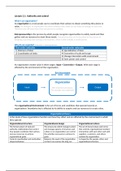College aantekeningen
All Lecutres Summary - Organization Theory & Design For Pre-MSc Organizational Theory, Design, and Change, ISBN: 9780273765608
- Instelling
- Rijksuniversiteit Groningen (RuG)
Summary of all lectures of Organizational Theory & Design. Summary is 58 pages long and includes (almost) every important model that will be asked during the exam. Including models, explanation of the models and some exam questions.
[Meer zien]





